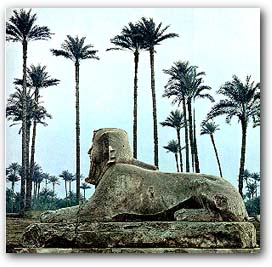| Alabaster Sphinx  Hatshepsut or Amenhotep II or Amenhotep III. Amenhotep III is thought to be the builder
of the Luxor Temple. Hatshepsut or Amenhotep II or Amenhotep III. Amenhotep III is thought to be the builder
of the Luxor Temple.
The Alabaster Sphinx is 8m (26 ft) long and 4m (13 ft) tall and weighs around 90 tons. It has
corroded over the centuries, but remains very impressive. This monument may have stood
outside of the Temple of Ptah along with the Colossus of Ramses II. The Alabaster Sphinx
spent many years lying on its side in water. This was responsible for the damage to the surface
of the monument.
The sphinx is sometimes referred to as the Calcite Sphinx. Calcite is an opaque white stone
that is often times called alabaster. The Alabaster was quarried at a place east of 'Amarna
called Hatnub. Calcite was also believed to have, in a mythical sense, solar connections. It
was not often used as a building material.
The type of figure known as a sphinx is created with the body of a lion and the head of
royalty. The lion is in a crouching position with its paws outstretched. The human head is
adorned with the covering reserved for kings of that particular period.
|





